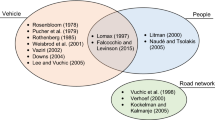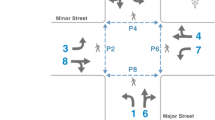Abstract
Improving train traffic control can be a cost-efficient way to improve train traffic punctuality and increase utilization of existing and future railway infrastructure. However, performance in train traffic control tasks currently involves working on a technical level in order to regulate the traffic flow. Working in a preventive manner is poorly supported and train traffic controllers are usually restricted to just solving problems as they occur. This often results in unnecessarily long delays and decreased timeliness of train traffic. The main objective of this paper is to describe a proposed control strategy and a case study, which evaluates the control strategy and the prototype tool derived from the research. By shifting the control paradigm to a high-level control strategy, many of today’s problems may be avoided, with benefits of the reduction in delays, improved timeliness and better utilization of the infrastructure. Twenty-one train traffic controllers participated in a case study, with a simulated prototype environment. The majority of the participating train traffic controllers were positive to the new concepts and ideas. Many of the important aspects of the proposed control strategy can be investigated with the simulation, but due to the complexity of train traffic some issues must be evaluated in an operative environment.






Similar content being viewed by others
References
Andersson AW, Sandblad B, Hellström P, Frej I, Gideon A (1997) A systems analysis approach to modeling train traffic control. Proceedings of WCRR 1997, vol C, Florence, pp 673–679
Andersson AW, Sandblad B, Nilsson A (1998) Improving interface usability for train traffic controllers in future traffic control systems. In: Mellit B, Hill RJ, Allan V, Sciutto G, Brebbia CA (eds) Computers in Railways VI, Lisbon. WIT press, Boston, pp 929–939
Bainbridge L (1987) The ironies of automation. In: Rasmussen J, Duncan K, Leplat J (eds) New technology and human error. Wiley, London
Billings CE (1997) Aviation automation, the search for a human-centered approach. Lawrence Erlbaum, Mahwah, NJ
Endsley MR (1988) Design and evaluation for situation awareness enhancement. Proceedings of the human factors society 32nd annual meeting. Santa Monica, CA
Endsley MR (1996) Automation and situation awareness. In: Parasuraman R, Mouloua M (eds) Automation and human performance theory and applications. Lawrence Erlbaum, Mahwah, NJ, pp 163–181
Lenior TMJ (1993) Analyses of cognitive processes in train traffic control. Ergonomics 36(11):1361–1368
Rasmussen J, Pejtersen AM, Goodstein LP (1994) Cognitive systems engineering. Wiley, Chichester, NY
Sandblad B, Andersson AW, Frej I, Gideon A (1997) The role of human–computer interaction in design of new train traffic control systems. Proceedings of WCRR 1997, vol A, Florence, pp 777–783
Vicente KJ (1999) Cognitive work analysis: toward safe, productive, and healthy computer-based work. Lawrence Erlbaum, Mahwah, NJ
Author information
Authors and Affiliations
Corresponding author
Rights and permissions
About this article
Cite this article
Kauppi, A., Wikström, J., Sandblad, B. et al. Future train traffic control: control by re-planning. Cogn Tech Work 8, 50–56 (2006). https://doi.org/10.1007/s10111-005-0019-3
Received:
Accepted:
Published:
Issue Date:
DOI: https://doi.org/10.1007/s10111-005-0019-3




